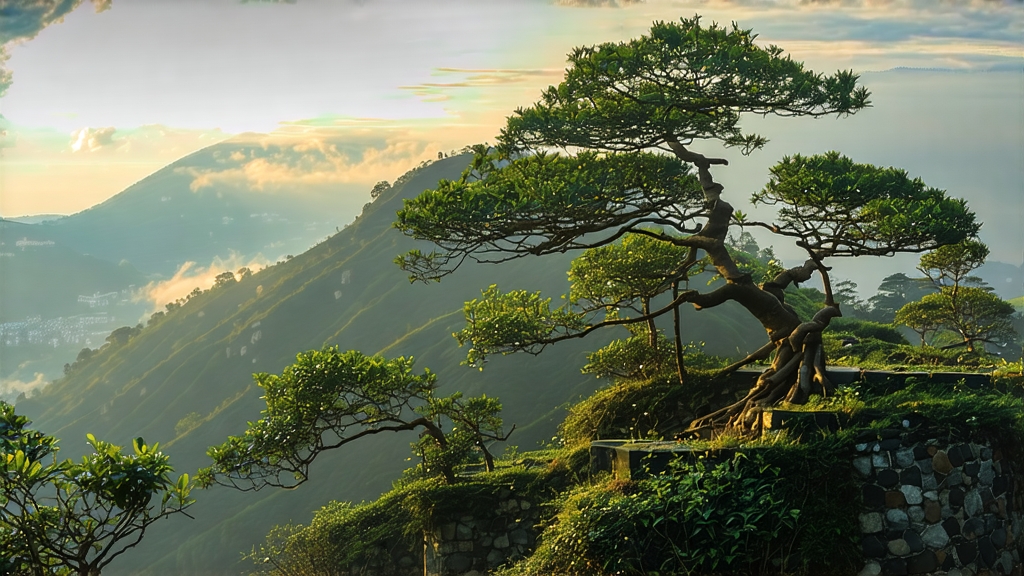
High above the Sichuan basin, where the Min River carves a path through perpetual mist, lies Meng Ding Mountain, the cradle of the world’s oldest recorded tea garden. It was here, in the mist-veiled terraces of Ganlu Temple, that Buddhist monks first coaxed the pale-gold liquor later christened Meng Ding Huang Ya—“the yellow bud of Meng Ding.” Mentioned in imperial tribute lists as early as 725 CE, this delicate yellow tea once traveled in bamboo-lined chests along the Tea-Horse Road to Chang’an, where Tang dynasty poets praised its “honeyed moonlight” aroma. For a millennium it remained an exclusive court luxury; when green tea fashions shifted in the Qing, production quietly lapsed, and Meng Ding Huang Ya slipped into obscurity. Only in the 1950s did state tea researchers rediscover the technique in the memory of a single octogenarian monk, restoring to the world a flavor that had charmed thirteen Chinese dynasties.
Meng Ding Huang Ya belongs to the smallest and most enigmatic of China’s six tea families—yellow tea—defined not by leaf shape but by a unique “sealed smothering” step that steals the greenness from the leaf while gifting it a mellow, chestnut-sweet character. Within the tiny yellow-tea universe, Meng Ding Huang Ya is further classified as “bud yellow tea,” meaning it is fashioned exclusively from the unopened spear-shaped buds and their attendant single leaf picked before the Qingming festival, when morning temperatures still hover around 10 °C and the mountain’s nitrogen-rich cloud cover slows photosynthesis, concentrating amino acids. The result is a pick so tender that a kilogram requires 42,000 such buds, all plucked within the thirteen-day window when their length matches the first joint of a novice nun’s little finger—an image still used by veteran pickers to train newcomers.
The craft begins the moment the buds descend the mountain in shallow bamboo baskets lined with fresh fern fronds to prevent bruising. At the tiny 800 m² workshop perched on a cliff ledge, the leaves undergo a gentle withering for ninety minutes on hemp cloth trays angled toward the rising sun; this evaporates surface moisture without waking the enzymes too aggressively. Next comes the kill-green, but here the temperature is lowered to 140 °C for just four minutes, intentionally under-fixing the leaf so that a whisper of oxidation remains possible. While green tea would now be rolled and dried, Meng Ding Huang Ya instead enters its defining phase—men huang, “sealed smothering.” The warm, still-pliable buds are piled 8 cm deep inside cedar boxes lined with wet calico; lids are fastened and the boxes slid into a 28 °C, 75 % humidity chamber for seventy-two hours. During this restless sleep the leaf’s own residual moisture and heat trigger a non-enzymatic browning, turning chlorophyll into pheophytin and converting harsh catechins into softer theaflavins. Every twelve hours the master lifts a lid, inhales, and adjusts the cloth: too grassy—add moisture; too fruity—raise the lid for five breaths. When the buds have achieved the color of polished ivory with a faint saffron rim, they are gently rolled for ninety seconds—just enough to set shape—then dried in three passes: charcoal basket firing at 80 °C, rest for tempering, 70 °C, rest again, and finally 60 °C until moisture falls to 5 %. The finished needle is slim and slightly curved, the color “golden at the tip, jade at the base,” a phrase coined by Song Huizong himself.
To brew Meng Ding Huang Ya is to court subtlety; aggression scares away its shy aromatics. Begin with mountain spring water whose TDS lies between 30–80 ppm; higher mineral content mutes the orchid note. Heat the water to 85 °C—any hotter and the bud’s velvety hairs scald, releasing an astringent greenness that seventy-two hours of men huang tried to erase. Choose a tall, thin-walled glass or a 120 ml porcelain gaiwan; transparency allows you to watch the buds stand upright, then slowly dive in choreography nicknamed “the monk’s bow.” Use 3 g of leaf for every 100 ml, rinsing for only three seconds to awaken the buds without washing away their downy fragrance. The first infusion, twenty seconds, yields a liquor the color